The English Village Explained: Britain’s Living History (6 page)
Read The English Village Explained: Britain’s Living History Online
Authors: Trevor Yorke

While the farmers built themselves stout new houses out in their fields, so the gentry set about displaying their wealth and status by erecting tasteful, classical country houses. Part of their ambitious schemes was usually to create a large landscaped park around their house, not very practical in the village where most manor houses stood. Some picked a new site away from the huddle of cottages and crofts but many chose to move the whole village instead! Emparkment could therefore be the final nail in the coffin for some struggling villages, which were simply replaced by a home farm. Alternatively it could be a new start for those where purpose-built settlements were provided for the dispossessed, out of sight of the mansion. These estate villages, usually built in brick or stone, were constructed to create a picturesque approach for visiting gentry rather than in benevolence towards the villagers and although they did offer a better standard of accommodation for the lucky ones invited to stay, it was also an opportunity to remove unwanted elements of the community.
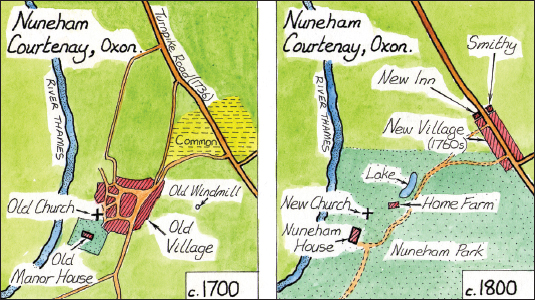
FIG 4.6:
A map showing
NUNEHAM COURTENAY, OXON
before and after the village was removed to make way for a new landscaped park. In this case a new settlement was built along the turnpike road in the 1760s while Nuneham House and a new church were erected on the old site
.
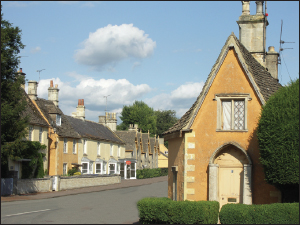
FIG 4.7 GREAT BADMINTON, GLOS:
Estate villages are among some of our most attractive, although the hordes of tourists which delight in their quaint and rustic features are often unaware of their relatively recent origins, as with this collection of fine buildings mostly dating from the 18th and 19th centuries, built comfortably out of view of the main house
.
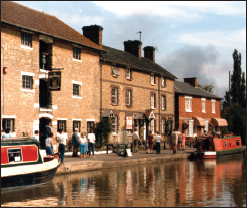
FIG 4.8 STOKE BRUERNE, NORTHANTS:
When the Grand Junction Canal arrived in the tiny village, new buildings and houses began to be built around this busy centre, affecting the layout of the village and leaving the older part rather relegated to the west. Industry and turnpike roads could cause similar long-term drift of villages towards the new centres of employment and trade
.
Those villages which had survived the hard times of the 14th and 15th centuries could grow again as the population recovered and then boomed, the extra housing required for them often resulting in encroachment on areas like the green and other common land. As well as the changes enforced by landowners and farmers,
many villages were influenced by the presence of a new industry, turnpike roads or canals. Factories, wharfs, inns, stables and housing for workers appeared around these sources of employment, often a short distance from the old settlement, marking a gradual shift away from its original core and towards the new source of commercial opportunity.
There were dramatic changes to the churches themselves as a result of the break from Rome and over the following century various outbursts of religious fervour saw interiors painted white, crosses broken and stained-glass windows smashed. It became a period of stagnation and decline for most parish churches as the gentry rather ignored them and the attendance of the congregation fluctuated. Now the priest was often the second son of a wealthy family and expected a fine new house. He might take more interest in building his new rectory or vicarage and visiting those of his class rather than in the body of the church and minds of his flock. As a result, dissenting religious groups like Quakers, Baptists and Methodists
attracted increasing congregations and built chapels, simple symmetrical structures, which grew in numbers especially from the late 18th century.
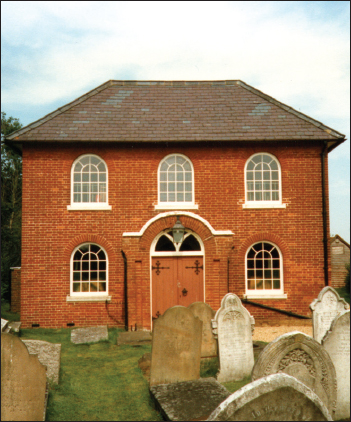
FIG 4.9 CHENIES, BUCKS:
Most chapels built for Nonconformist worshippers in the simple, symmetrical-fronted buildings like this example, with a large open space and gallery within
.
Partly due to social and economic changes but also because of the void left by the dissolved monasteries, hospitals and chantries, the role of the parish was to change in this period, as it was chosen to take on secular duties, in addition to its ecclesiastical ones. From 1538 each parish had to record its baptisms, marriages and burials in a register. In 1555 the Highways Act made parishes responsible for the maintenance of roads, while the 1601 Poor Laws put the raising and distribution of poor relief in their hands. New, unpaid officials were elected from the parish to administer these duties, including a constable who would report regularly on matters of crime and disorder, and the churchwarden who was responsible for church maintenance and the welfare of the parishioners. In addition to this, the collection of local, county and national taxes fell upon their shoulders.
In this period there was a widening gap between the various classes of society. With the end of the feudal system, landowners who previously had contact with members of the community through the organising of the agricultural calendar now had little need to communicate with the majority of them, as the land was leased or had been sold off. The ruling class ranged from dukes, lords and baronets (increasingly ones who had climbed in rank rather than being members of the old aristocratic families), down to the lesser gentlemen and squires, with their standing being judged mainly on the quantity of land they owned. Increasingly, however, a good education, appreciation of science and farming and an understanding of the arts became a sign of good breeding. Many 18th-century gentlemen spent their early years abroad on grand tours which took in Paris and Rome, to study Classical art and architecture and more often than not brought half of it back with them! Their new country houses were often built to house these new acquisitions.
Further down the social order were the lesser landowners or freeholders who in addition to managing their farms would also fill the positions of the various parish officials. In areas affected by enclosure though, some would find it hard to pay for new buildings, hedging, fencing and legal expenses, so they might sell up and become tenants or use their capital to move into other trades. Generally this yeoman class diminished from the 17th century and the farmer, renting a new enclosed farm, became dominant in the middle order of the village.
At the bottom of the pile were the cottagers, landless labourers and domestic servants who in the 18th century still made up the majority of villagers. Despite the improving living conditions and levels of education for some, this group still tended to live in primitive accommodation and were widely superstitious, illiterate and more influenced by folklore than the word of
the vicar. Many men would be employed on a seasonal basis at the local hiring fairs, while the women and children would gain additional funds from grazing livestock, domestic work, or carrying out a local craft.
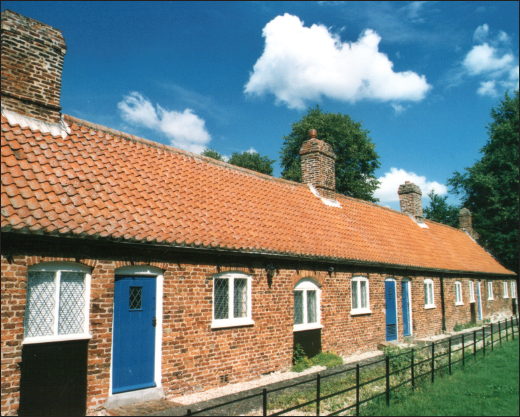
FIG 4.10 TATTERSHALL, LINCS:
Almshouses were originally provided here by Lord Cromwell as part of his complex of castle, church and college. These brick buildings were later replacements dating from the early 17th century and are typical of many found in villages, having a single-storey, matching doors and being set in a row or around a courtyard
.
The parish poor rates introduced in 1601 were designed to help those of this class unable to support themselves, but as their numbers multiplied through this period there were various alterations to the system and grumblings rose amongst ratepayers about the cost to themselves. While the enclosures deprived these poorer villagers of land for grazing, those who had not left the village were to find it harder to make ends meet in the next period as industrialisation killed off even the cottage industries they now relied upon.

FIG 4.11 EXEMPLAR VILLAGE c1800:
Our imaginary village has entered the industrial age. On the hill in the distance a local lord has built his new mansion and has converted the old fields into a sweeping landscape park. To the right a fulling mill with its chimney has been built alongside the river and a wharf created next to the new canal which now passes along the valley. The village has drifted down towards these sources of employment leaving the older part in the foreground on the outskirts of the settlement. In front of us the exterior of the church has changed little while the manor house to the left has been re-built a number of times. The high wall on the right encloses the garden of the new vicarage, but still retains the shape of the two medieval crofts which had been taken over by their neighbour in the previous view. On the site of his house now stands a new stone cottage which the man across the road can only look at enviously. His own timber-framed house, covered in a protective plaster layer, was built some years before on the old green. The only part of the green still remaining is around the pond by the T-junction
.
